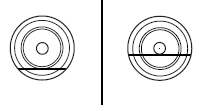Driving through water


If driving through deep or standing water is unavoidable, proceed very slowly. Never drive through water that is higher than the bottom of the wheel rims (for cars) or the bottom of the hubs (for trucks).
When driving through water, traction or brake capability may be limited.
Also, water may enter your engine’s air intake and severely damage your engine or your vehicle may stall. Driving through deep water where the transmission vent tube is submerged may allow water into the transmission and cause internal transmission damage.
Once through the water, always dry the brakes by moving your vehicle slowly while applying light pressure on the brake pedal.
Wet brakes do not stop the vehicle as quickly as dry brakes.
See also:
Overview
New, industry-exclusive technologies and engaging design featuring
world-class craftsmanship and materials further elevate the 2011 Lincoln MKX
midsize luxury crossover.
Leading the wide-ranging ...
3.5-liter ecoboost V6
Nine out of 10 MKT retail customers opt for twin-turbo 3.5-liter EcoBoost V6,
an engine that provides V8 performance with the fuel economy of a V6. In terms
of horsepower from optional engines, the ...
Cargo & Towing
The MKX's car-based construction again shows its benefit in cargo volume;
body-on-frame trucks tend to have less for an equivalent exterior size. My MKX
had a power liftgate, which comes in an opt ...
